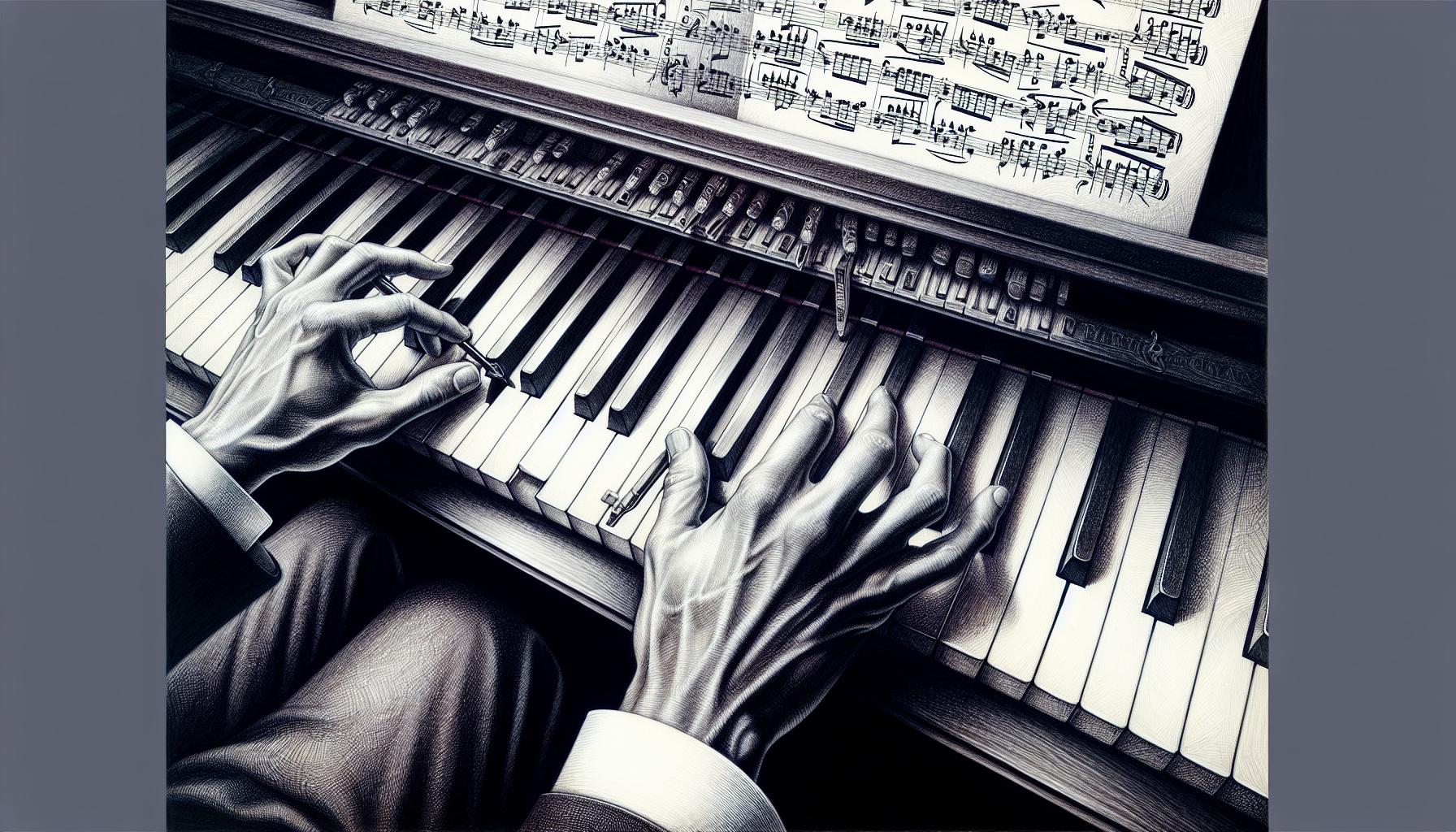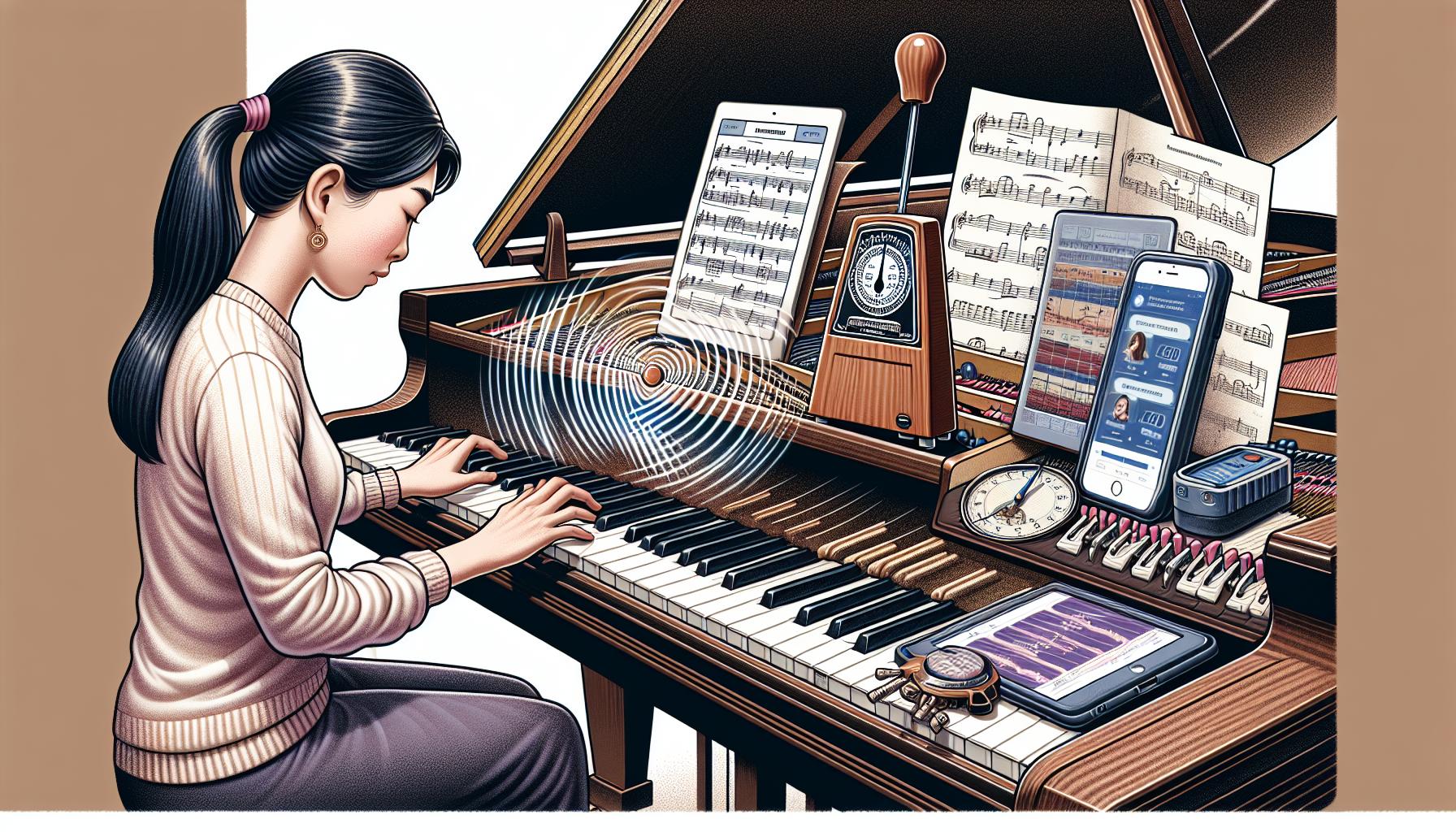Learning a new piano piece can feel like climbing a mountain. But what if it didn't have to? Imagine breaking down that towering challenge into manageable steps, making the journey not only easier but also more enjoyable. It's all about strategy, and with the right approach, anyone can master their favorite compositions more efficiently.
The key lies in understanding the piece, setting realistic goals, and practicing smart, not just hard. Whether you're a beginner or an experienced pianist, these techniques can transform your practice sessions, turning frustration into progress. Let's dive into how you can learn a new piano piece efficiently, making every minute at the keyboard count.
Analyzing the Piece
Before diving into playing a new piano piece, it's crucial to analyze it thoroughly. This process involves understanding the composition's structure, identifying challenging sections, and recognizing its emotional and expressive demands. By doing so, pianists can approach their practice with strategic insight, ensuring that they focus on the areas that require the most attention.
The first step in analyzing a piece is to read through the score without touching the piano. By visually scanning the music, they can note any repetitions, variations, and key changes. This high-level overview gives insight into the composer's intentions and the piece's overall narrative flow. Pianists should also pay attention to tempo markings, dynamics, and other notations that provide clues about the intended emotion and character of the piece.
Next, identifying the technically demanding sections is essential. These are often the spots with rapid note sequences, complex chords, or intricate rhythms. Marking these areas on the score helps pianists allocate extra practice time to them. Additionally, by understanding the technical challenges upfront, pianists can tailor their practice techniques, such as slow practice or hands-separate practice, to address these difficulties effectively.
Another crucial aspect of analysis is understanding the harmonic progression and melodic contours of the piece. This knowledge not only aids in memorization but also enriches the pianist's interpretative approach. Recognizing the key centers and modulations can help pianists anticipate shifts in mood and dynamics, allowing for a more expressive performance.
Furthermore, understanding the historical and cultural context of the piece can profoundly impact its interpretation. Researching the composer's life, the period in which the piece was written, and its performance history can provide valuable insights. This broader perspective might influence tempo choices, phrasing, and the overall expressiveness of the performance.
Lastly, it's beneficial for pianists to listen to several recordings of the piece by renowned artists. Listening to different interpretations offers a range of perspectives and can inspire pianists to explore various expressive possibilities. However, while it's helpful to draw inspiration from these performances, pianists should strive to develop their personal interpretation that feels true to themselves and coherent with their understanding of the piece.
By analyzing a new piano piece from these various angles, pianists equip themselves with a deep understanding of the work. This preparatory step ensures that practice sessions are guided by an informed and thoughtful approach, ultimately leading to a more meaningful and satisfying rendition of the piece.
Setting Realistic Goals

Embarking on the journey to master a new piano piece can be as exciting as it is daunting. To navigate this challenging process efficiently, setting realistic goals is paramount. These goals act as beacons, guiding pianists through the stages of learning, allowing them to measure progress and maintain motivation.
Pianists should start by breaking down the piece into manageable sections. This approach makes it easier to tackle the composition without feeling overwhelmed. It’s helpful to categorize these sections based on difficulty, familiarity, or technical demands. By doing so, one can prioritize which parts to focus on first, ensuring that practice time is used efficiently.
Allocating practice time wisely is another crucial aspect of setting realistic goals. Instead of setting an unattainable goal of mastering the entire piece in a short period, pianists should aim for smaller, achievable milestones. For instance, perfecting a specific measure or mastering a challenging rhythm. These smaller goals add up over time, leading to significant progress that aligns with the individual's overall objectives.
Incorporating regular breaks into practice sessions is also vital. Studies suggest that our brains assimilate information more effectively when they're given time to rest in between learning activities. Therefore, short, focused practice sessions with breaks can be more beneficial than marathon sessions without rest.
Here's a simple table illustrating how pianists might divide their practice time:
| Week | Goal | Section(s) to Focus On |
|---|---|---|
| 1 | Memorize the first theme | A |
| 2 | Work on technical challenges in the B section | B |
| 3 | Improve expression in the recapitulation | C |
| 4 | Increase tempo to performance speed | A, B, C |
Engagement with the piece outside of direct practice can deepen one's understanding and connection to the music. Listening to recordings, analyzing the score away from the piano, and studying the historical context of the piece are complementary activities that enrich the learning process. These should be factored into one's goals, as they provide valuable insights that can influence interpretation and performance.
Feedback from a teacher or trusted peer is invaluable. They can offer perspectives that a pianist might not consider on their own. Regularly scheduled check-ins provide milestones to work towards and can help adjust goals as needed based on progress and feedback.
Effective Practice Techniques

When embarking on the journey of mastering a new piano piece, adopting effective practice techniques is crucial. These techniques not only enhance the efficiency of practice sessions but also ensure progress is both measurable and rewarding.
One fundamental approach is to incorporate slow practice methods. Playing a piece at a slower tempo allows musicians to focus on precision, dynamics, and emotion, laying a solid foundation before increasing the speed. This meticulous approach ensures that mistakes aren’t ingrained during early practice.
Another key strategy is segmented practice. Dividing the piece into smaller, manageable sections helps tackle challenging parts with more focus. Musicians can concentrate on a single measure or phrase at a time, repeating it until it’s polished before moving to the next. This method not only streamlines the learning process but also builds confidence as each segment is mastered.
Hands-separate practice is also instrumental for pianists. Initially focusing on one hand at a time simplifies complex passages and allows for concentrated attention on hand-specific techniques. Once comfort and accuracy are achieved independently, hands-together practice can commence, integrating the piece as a cohesive whole.
Incorporating dynamic visualizations into practice sessions can also be highly beneficial. Visualizing the keyboard and imagining finger movements when away from the piano reinforces muscle memory and aids in internalizing the piece. This mental practice can be particularly useful during breaks or when a piano is not accessible.
To ensure that practice sessions remain focused and productive, setting specific goals for each session is paramount. Goals could range from perfecting a certain number of measures to mastering a specific technical aspect. They provide a clear direction and make it easier to track progress.
Finally, it’s essential to incorporate regular feedback into the learning process. Whether it’s from a teacher, peer, or through self-assessment, feedback offers valuable insights on areas for improvement. Additionally, recording practice sessions and listening back can unveil nuances that might not be apparent in the moment.
By employing these effective practice techniques, learners can navigate the complexities of a new piano piece with confidence and clarity. Fostering a structured yet flexible approach to practice is key to both enjoying the learning journey and achieving musical mastery.
Utilizing Practice Tools

When embarking on the journey to master a new piano piece, leveraging various practice tools can significantly streamline the learning process. From metronomes to piano learning apps, these resources offer invaluable support in honing one's skills efficiently.
Metronomes are quintessential for developing a strong sense of timing and rhythm. Setting the metronome to a slow tempo allows musicians to play through tricky passages with precision. Gradually increasing the speed as they become more comfortable ensures that they maintain accuracy at the piece's intended tempo. This tool is especially useful when practicing segmented and slow practice methods, ensuring that each note and chord is played with the correct rhythm and pacing.
Another powerful asset in a pianist's toolkit is piano learning software and apps. These digital platforms often include features like interactive sheet music that lights up to indicate which notes to play next, performance recording capabilities to review one's playing, and personalized feedback that highlights areas for improvement. Some popular apps also offer step-by-step lessons for pieces spanning various genres and difficulty levels, making them suitable for both beginners and advanced players looking to expand their repertoire.
For a more tactile approach, fingering charts and hand position guides are invaluable, especially for visual learners. These tools can provide a clear roadmap of how to position one's hands and fingers for different chords and passages within a piece. By visualizing and practicing the recommended finger placements, pianists can avoid common technical mistakes and ensure efficient hand movements across the keyboard.
Lastly, video tutorials by experienced pianists and instructors offer a wealth of knowledge that can complement traditional practice. Watching someone else play the piece can uncover new insights into phrasing, dynamics, and emotion, which might not be immediately apparent from the sheet music alone. Many of these tutorials also include tips on overcoming specific challenges associated with the piece, offering personalized guidance that can accelerate one's learning curve.
By integrating these tools into their practice routines, pianists can not only learn new pieces more swiftly but also deepen their musical understanding and technical proficiency. Whether it's keeping time with a metronome, learning through interactive software, visualizing finger placements, or gleaning insights from video tutorials, each tool offers a unique avenue for growth and mastery in the art of piano playing.
Staying Motivated

Learning a new piano piece can be a challenging journey, requiring not just time and patience but also a constant stream of motivation. Staying motivated isn't always easy, especially when progress seems slow or the piece at hand feels too complex. However, there are effective strategies that can help pianists maintain their enthusiasm and drive throughout the learning process.
Set Realistic Goals
One key to staying motivated is setting realistic, achievable goals. Breaking down the learning process into smaller, manageable tasks makes the overall goal seem less daunting and more attainable. For instance, mastering a single measure or even a small phrase each practice session can provide a sense of accomplishment that fuels further progress.
Celebrate Small Victories
Every small victory on the piano is worthy of celebration. Whether it's nailing a difficult chord progression, playing through a section without mistakes, or simply managing to practice daily, acknowledging these wins can provide a significant motivational boost. Celebrating these achievements reminds learners of how far they've come and why they started learning the piano in the first place.
Maintain a Practice Routine
Consistency is key in making steady progress. Establishing a regular practice routine helps in ingraining the habit of practising, making it easier to sit down at the piano even on days when motivation is low. It's not about practicing for hours every day but rather ensuring that even short, focused practice sessions are a non-negotiable part of the daily routine.
Find Inspiration
Inspiration can be a powerful motivator. Listening to recordings of the piece being learned, performed by accomplished pianists, can provide a burst of enthusiasm and a clear goal to strive towards. Moreover, attending live concerts, joining piano communities, or collaborating with other musicians can rekindle one’s passion for music and drive the desire to learn and improve.
Use Social Support
Sharing the journey of learning a new piano piece with friends, family, or a piano teacher can significantly impact motivation. Regular updates on progress, discussing challenges, and receiving encouragement and feedback not only foster social support but also accountability. Knowing that others are invested in one's progress can be a powerful motivator to keep pushing forward.
Conclusion
Mastering a new piano piece doesn't happen overnight. It's a journey filled with small steps and big leaps forward. By setting achievable goals and celebrating each milestone, learners can keep their motivation high. Consistency in practice builds the foundation for progress, while inspiration drawn from music itself fuels the passion. And let's not forget the power of support from those around us. Whether it's friends, family, or a dedicated teacher, having someone to share the highs and lows with makes the journey all the more rewarding. So keep these strategies in mind and watch as each note, each chord, brings you closer to the music you aspire to create.
Harlan Kilstein began playing piano during covid with no piano background at all. He taught himself how to play learning what to do and what not to do.
Today he's an advanced intermediate player and can help you grow in your skills because he learned all this on his own.







